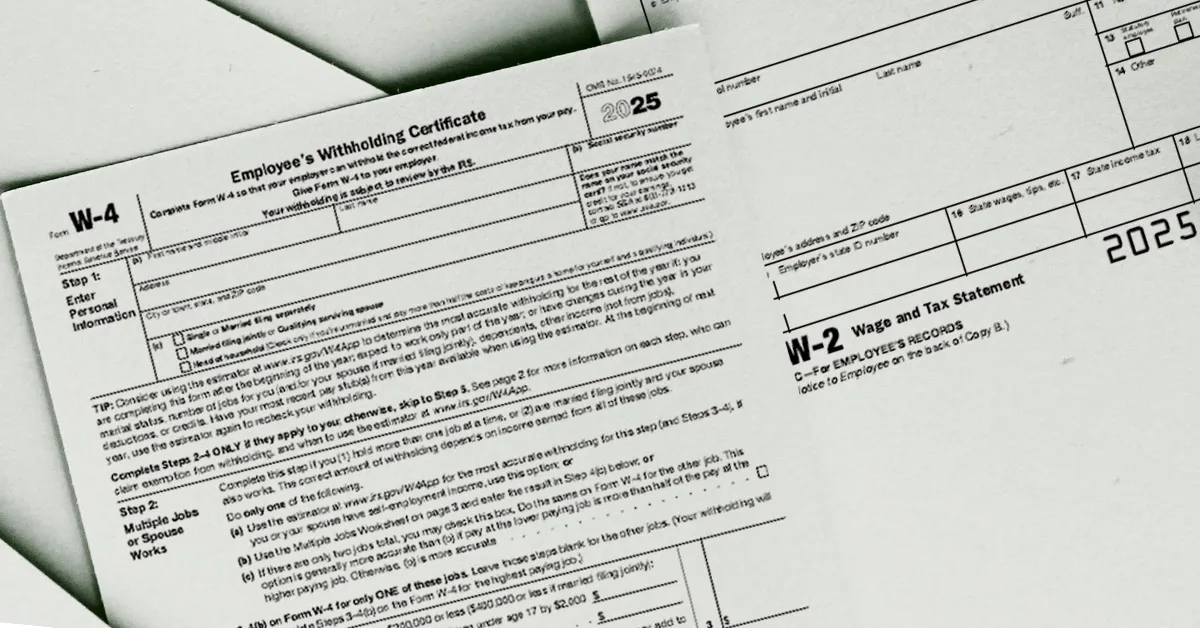
When it comes to managing payroll, understanding the difference between W2 vs. W4 is essential for employers. These forms are more than just paperwork — they play a critical role in ensuring accurate tax filings, smooth employee onboarding, and legal compliance. But what exactly is the difference between these forms — and how can knowing this benefit your business?
When employers hire employees, each new employee must complete a tax form to receive their paycheck through a payroll system. Having the proper knowledge of these forms can help aid both sides in the employer and employee relationship. The W2 and W4 forms serve different purposes in payroll management, but both are crucial.
What is the Difference Between a W2 and a W4?
Understanding the difference between W2 vs. W4 ensures that employers correctly process payroll and employees avoid surprises come tax time.
The W4 form is completed by new employees when they are hired, dictating how much tax is withheld from each paycheck.
The W2 form is issued at the end of the year to file tax returns by summarizing total earnings and taxes withheld.
Let’s explore each of these forms in more detail.
W4 Forms
The federal government uses the W4 form for tracking purposes. At the heart of the form, the W4 captures elections for taxes that every employee makes for their payroll taxes. This form contains basic personal information items such as full name, address, social security number and tax allowances. This is the beginning of the cycle to get to the W2 form. When completing the form, employees elect certain tax criteria like, single, married or head of household. The information in these selections indicates how taxes are later calculated based on the employee’s wages.
The W4 form is very straightforward to complete, but it is vital for determining employee tax withholdings. It directly influences paycheck deductions throughout the year, making it a key part of payroll management.
(Tip: For the W2 form and other payroll and compliance resources, check out our Government Forms and Info page!)
W2 Forms
Employers issue a W2 form at the beginning of every year to all employees paid during the previous year. In addition to salary, this form considers what elections the employee made when completing the W4 form during onboarding. Employer-centered items such as 401k, health insurance, other pre-tax items, social security caps in wages are all considered when producing the personalized information on a W2 form.
W2 Filing
Employers then submit this form to the SSA (Social Security Administration) and IRS (Internal Revenue Service) for income and tax tracking. The information on the W2 ensures that the government knows how much an individual earned for the past year and how much tax the employer withheld over that period on the employee’s behalf. The employer’s W2 submission allows the IRS to verify that they have collected the correct amount of tax dollars from the employee. This also helps the IRS ensure that they have accurately attributed contributions to Medicare and social security for each employee.
Because these submissions are so critical, employers often rely on a third-party payroll company like Green Payroll to guarantee correct form filing.
Employees will then later include the W2 form when filing their tax returns. This will verify their income and the amount of taxes already paid through employer withholding.
But why do both the employer and the employee need to submit the same form? Having the W2 information from both parties helps the government cross-reference pay and tax information. When employees submit their tax returns, the employer’s W2 acts as a verification tool to ensure no discrepancies between reports. If there are any differences between reports, this can potentially trigger an audit or investigation by the IRS. (Check out our article on payroll compliance for more information on tips to ensure tax compliance!)
W2 Form Overview
The main elements included in a W2 form are:
- All wages reported for the year, along with what amounts were paid for the employee taxes based on W4 elections.
- Pre-tax boxes that can help lower total tax for the year. (This is what employers and insurance companies talk about when speaking about pre-tax elections.)
To help avoid any complications at tax time, employees should know what benefits their employers provide and how these are classified as taxable items/events. Employers typically report health plans, 401(k) plans, and some other benefits in a pre-taxable category on the W2. The setup can have major tax implications, so it’s important for employees to be aware.
(Stay tuned for a more detailed walkthrough of the W2 form where we walk through each box step-by-step!)
Bonus Tax Tip!
The goal (in my opinion) should be to pay taxes throughout the year in such a way that, when you file your tax return and W2, you owe no outstanding tax and no refund is due. From a cash flow standpoint, there are no surprises on either side — you simply pay your taxes as you earn. This way, you do not overpay only to have the government issue you back a refund. Likewise, not withholding the proper tax amount during the year can quickly turn refunds into a liability owed back to the IRS. There are many reasons for someone to have more or less tax withheld than needed throughout the year, but from a perspective of cash flow, I see this method as one of the best ways to save yourself from potential headaches!
W2 vs W4: Practical Tips for Employers
For businesses, especially small to mid-size companies, staying on top of W2 vs W4 forms can feel overwhelming. One best practice is to ensure all new employees complete their W4 form correctly during onboarding. At year-end, review W2 forms to ensure they accurately reflect each employee’s earnings and withholdings. Using a payroll service like Green Payroll can simplify this process, ensuring compliance and reducing the burden on your internal team.
In conclusion, the W4 and W2 forms are both part of the same tax withholding system in the US, and knowing how to correctly set up and read both will help create a better relationship for the employer and employee. If you want to ensure compliance with tax regulations and ease your payroll burden at the same time, consider using a trusted payroll service like Green Payroll.
Further Reading
For more helpful overviews of government forms, check out these articles below:
